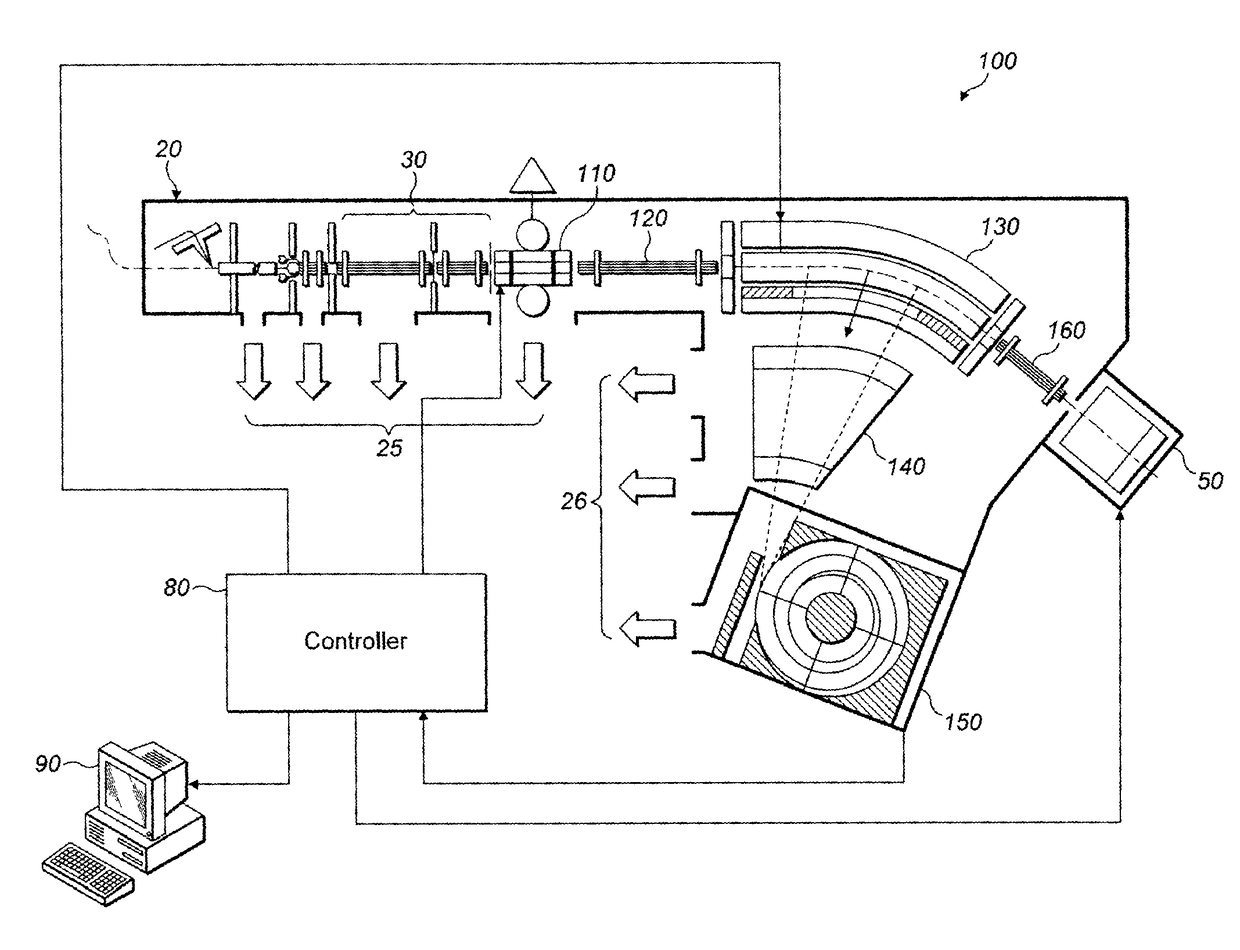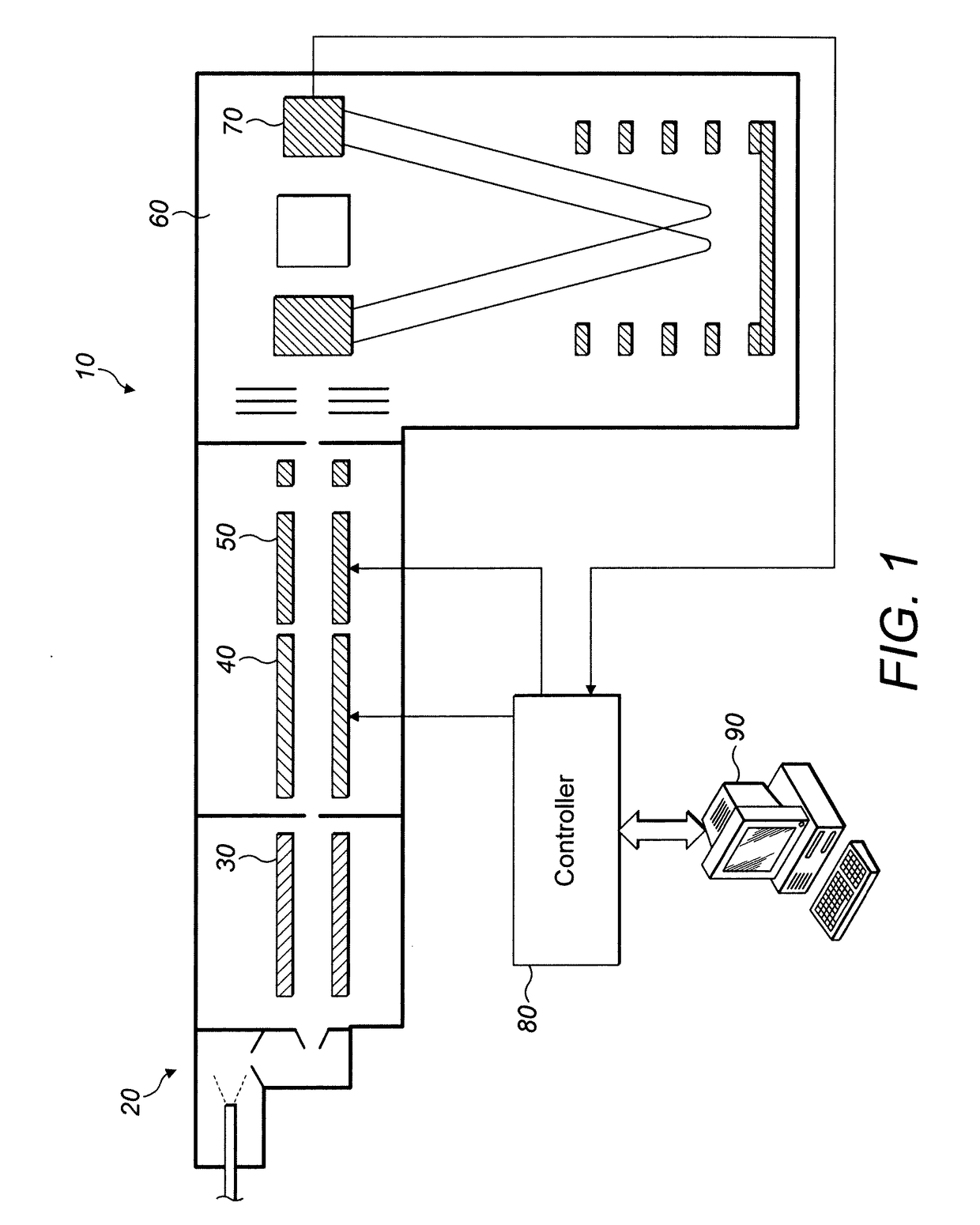Method of tandem mass spectrometry
a tandem mass spectrometry and tandem mass spectrometry technology, applied in the field of tandem mass spectrometry, can solve the problems of affecting the accuracy of the analysis, and affecting the overall performance of the analysis, so as to achieve the effect of increasing the throughpu
- Summary
- Abstract
- Description
- Claims
- Application Information
AI Technical Summary
Benefits of technology
Problems solved by technology
Method used
Image
Examples
first embodiment
[0038]Turning then first to FIG. 1, an apparatus suitable for implementation of a method embodying the present invention is shown. The arrangement of FIG. 1 is referred to in the art as a Q-TOF.
[0039]In detail, the arrangement of FIG. 1 is a tandem mass spectrometer 10 having an ion source 20. The ion source 20 is, in the pictured embodiment, an electrospray ion source but may be any other suitable form of ion source, such as, for example a MALDI ion source.
[0040]Ions from the ion source 20 pass through ion optics / an ion guide 30 and into a quadrupole mass filter 40. The quadrupole mass filter 40 is capable of selecting a relatively narrow window of mass to charge ratios of ions from the ion source, dependent upon the voltages applied to the quadrupole electrodes. The ions in the relatively narrow mass window which are allowed to pass through the quadrupole mass filter 40 then enter an inline fragmentation cell 50 where they are fragmented, or not, in a manner to be described in con...
second embodiment
[0058]Turning now to FIG. 2, an apparatus suitable for use with the method of embodiments of the present invention is shown.
[0059]In FIG. 2, a tandem mass spectrometer 100 has an ion source 20 which, again, is shown as an electrospray ion source but might be any other suitable form of quasi continuous or pulsed ion source.
[0060]Ions from the ion source 20 pass through ion optics 30 and into a linear trap 110. The linear trap may be a quadrupole ion trap or might have higher order (hexapole or octapole) rod electrodes instead.
[0061]The linear trap 110 stores ions from the ion source 20 within a selected subsidiary mass range (segment) in accordance with the selected algorithm (FIG. 6, and step 630 in particular). Stored ions of the chosen segment are then ejected from the linear trap by adjusting the DC voltage on end caps thereof, in known manner, so that the ions pass through second ion optics 120 into a curved or C-trap 130. The C-trap 130 has a longitudinal axis which is curved a...
third embodiment
[0070]FIG. 3 shows an apparatus suitable for use with the method embodying the present invention. In brief, this apparatus is a quadrupole / Orbitrap™ hybrid, again with the collision cell in a “dead end” location. The apparatus, but again not the specific methodology for its control, is described in further detail in our currently unpublished, copending application number GB 1108473.8 filed 20 May 2011 entitled “Method and apparatus for mass analysis”.
[0071]In detail, a tandem mass spectrometer 200 in accordance with the arrangement of FIG. 3 includes an ion source 20 (again, an electrospray ion source is shown schematically but other ion sources can be employed). Ions from the ion source pass through an rf only S-lens 210 and into a bent flatapole 220. This arrangement is rf only and the amplitude of the voltage applied to the flatapole 220 is mass dependent.
[0072]Ions exiting the flatapole 220 enter a quadrupole mass filter 40. Here, a subset of ions for a given ith segment is sele...
PUM
 Login to View More
Login to View More Abstract
Description
Claims
Application Information
 Login to View More
Login to View More - R&D
- Intellectual Property
- Life Sciences
- Materials
- Tech Scout
- Unparalleled Data Quality
- Higher Quality Content
- 60% Fewer Hallucinations
Browse by: Latest US Patents, China's latest patents, Technical Efficacy Thesaurus, Application Domain, Technology Topic, Popular Technical Reports.
© 2025 PatSnap. All rights reserved.Legal|Privacy policy|Modern Slavery Act Transparency Statement|Sitemap|About US| Contact US: help@patsnap.com



